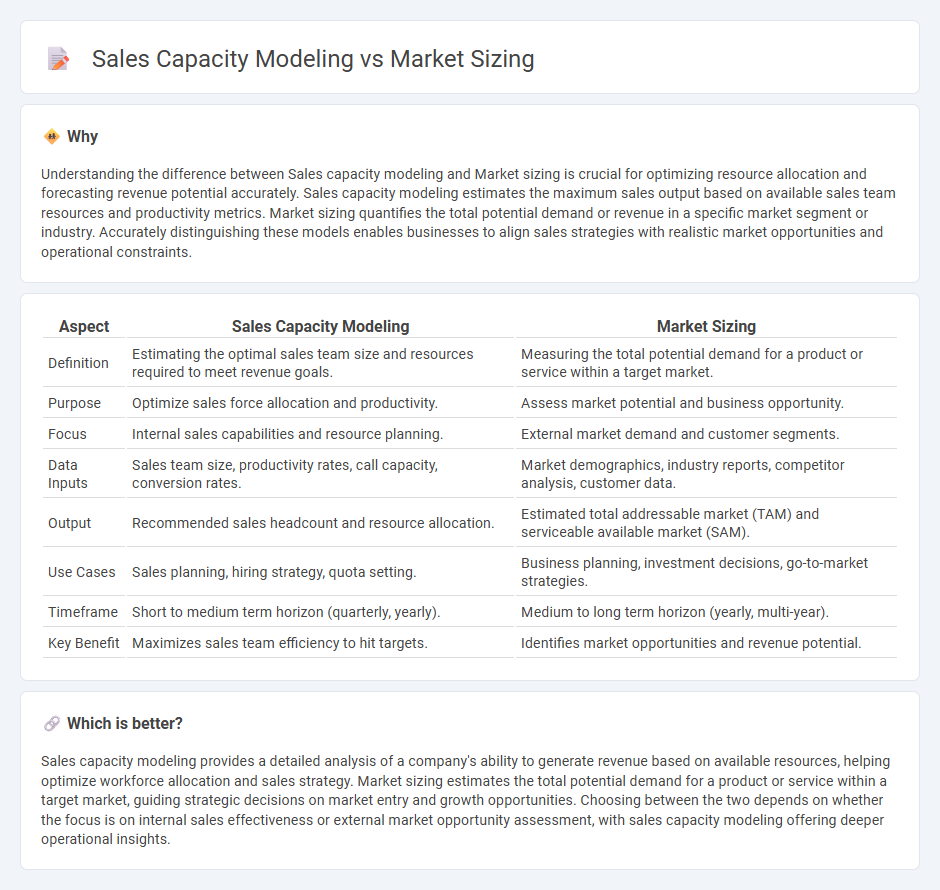
Sales capacity modeling quantifies the maximum potential sales volume a team can achieve based on resources, employee performance, and operational constraints, while market sizing estimates the total demand available within a specific market or segment. Understanding sales capacity helps optimize workforce allocation and forecast achievable revenue, whereas market sizing guides strategic decisions by identifying growth opportunities and market share potential. Explore deeper insights into how aligning these models drives accurate sales forecasting and business growth strategies.
Why it is important
Understanding the difference between Sales capacity modeling and Market sizing is crucial for optimizing resource allocation and forecasting revenue potential accurately. Sales capacity modeling estimates the maximum sales output based on available sales team resources and productivity metrics. Market sizing quantifies the total potential demand or revenue in a specific market segment or industry. Accurately distinguishing these models enables businesses to align sales strategies with realistic market opportunities and operational constraints.
Comparison Table
| Aspect | Sales Capacity Modeling | Market Sizing |
|---|---|---|
| Definition | Estimating the optimal sales team size and resources required to meet revenue goals. | Measuring the total potential demand for a product or service within a target market. |
| Purpose | Optimize sales force allocation and productivity. | Assess market potential and business opportunity. |
| Focus | Internal sales capabilities and resource planning. | External market demand and customer segments. |
| Data Inputs | Sales team size, productivity rates, call capacity, conversion rates. | Market demographics, industry reports, competitor analysis, customer data. |
| Output | Recommended sales headcount and resource allocation. | Estimated total addressable market (TAM) and serviceable available market (SAM). |
| Use Cases | Sales planning, hiring strategy, quota setting. | Business planning, investment decisions, go-to-market strategies. |
| Timeframe | Short to medium term horizon (quarterly, yearly). | Medium to long term horizon (yearly, multi-year). |
| Key Benefit | Maximizes sales team efficiency to hit targets. | Identifies market opportunities and revenue potential. |
Which is better?
Sales capacity modeling provides a detailed analysis of a company's ability to generate revenue based on available resources, helping optimize workforce allocation and sales strategy. Market sizing estimates the total potential demand for a product or service within a target market, guiding strategic decisions on market entry and growth opportunities. Choosing between the two depends on whether the focus is on internal sales effectiveness or external market opportunity assessment, with sales capacity modeling offering deeper operational insights.
Connection
Sales capacity modeling directly impacts market sizing by providing a realistic assessment of the sales team's ability to capture potential market demand. Accurate market sizing relies on sales capacity data to forecast achievable revenue targets and allocate resources effectively. Integrating these models enhances strategic planning and optimizes sales force deployment for maximum market penetration.
Key Terms
Total Addressable Market (TAM)
Market sizing quantifies the Total Addressable Market (TAM) by estimating the overall revenue opportunity available for a product or service within a specific industry or geographic region. Sales capacity modeling evaluates a company's ability to capture a portion of the TAM by analyzing sales resources, team efficiency, and operational constraints. Explore how integrating TAM assessment with sales capacity modeling can optimize strategic planning and market penetration.
Sales Headcount
Market sizing determines the total demand for a product within a specific market, providing a macro-level estimate of potential revenue. Sales capacity modeling calculates the optimal number of sales representatives needed to achieve revenue goals, considering factors like sales cycle length, average deal size, and rep productivity. Explore deeper insights to align your Sales Headcount with market opportunities effectively.
Quota Allocation
Market sizing quantifies the total potential customer base and revenue opportunity within a specific market, essential for strategic planning and resource allocation. Sales capacity modeling evaluates the optimal number of sales representatives and their productivity to meet revenue targets, directly impacting quota allocation effectiveness. Explore how integrating market sizing with sales capacity modeling drives precise quota allocation and maximizes sales performance.
Source and External Links
How to Conduct a Market Sizing Exercise: A Step-by-step Guide - Market sizing evaluates the volume or revenue of a market, helping businesses understand potential reach and value across broad or niche markets, at national or global levels, guiding strategic decisions and investment priorities.
Market Sizing | Formula + Calculator - Wall Street Prep - Market sizing is a top-down forecasting approach estimating a product's total addressable market (TAM) and revenue opportunity, often used early in a company's lifecycle to assess market entry viability based on customer demand and pricing.
Market Sizing: Step-By-Step Guide with Examples (2025) - Market sizing estimates the annual spending of a product category and is essential for strategic planning, resource allocation, product development, pricing, investment decisions, and market entry or expansion.
 dowidth.com
dowidth.com